This is a Taron Chic, a vertical half frame 35mm scale focus camera made by Taron Company Limited of Tokyo Japan starting in 1961. The Chic shoots 18mm x 24mm “half-frame” exposures on regular 35mm film. Unlike most half frame 35mm cameras, the film transports vertically, rather than horizontally which means the default orientation for the half frame images is in landscape, rather than portrait orientation like half-frame cameras with a horizontal film transport. The Taron Chic is very compact and came with a selenium cell exposure meter with a unique color matched exposure system that was thought to simplify exposure readings for beginners. The camera was not produced for long, as it’s parent company would go out of business a few years after it’s release.
 Film Type: Half-Frame 135 (35mm)
Film Type: Half-Frame 135 (35mm)
Lens: 30mm f/2.8 Taronar E.C. coated 4-elements
Focus: 2 feet to Infinity w/ Color Coded Zone Indicators for Portrait, Group, and Scenery
Viewfinder: Scale Focus with 30mm Projected Frame Lines
Shutter: Taron-L X
Speeds: B, 1/30 – 1/250 seconds (indicated by colors from blue to red)
Exposure Meter: Uncoupled Selenium Cell w/ Color Coded Exposure Indicators
Battery: None
Flash Mount: Coldshoe and M and X Flash Sync
Weight: 374 grams
Manual: http://www.cameramanuals.org/pdf_files/taron_chi-booklet.pdf
How these ratings work |
The Taron Chic is a very distinct looking camera that shoots half frame images in a normal landscape orientation. To accomplish this, the body is designed to be held vertically, which poses a few problems. Ergonomically the camera has some challenges, but once you get past that, the wide depth of field, and excellent lens reward you with some really great images. If you like cameras that don’t look like much else out there, you could do a lot worse than this Taron Chic. | ||||||
| Images | Handling | Features | Viewfinder | Feel & Beauty | History | Age | |
| 2 | 0 | 1 | 1 | 2 | 0 | 20% | |
| Bonus | +1 for a very unique design that’s unlike nearly anything else out there | ||||||
| Final Score | 8.2 | ||||||
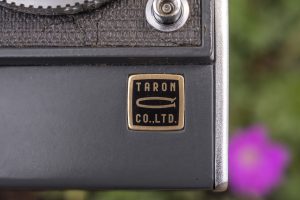
History
In the early days of the Japanese optical industry, there were a huge number of companies and brand names that came and went with little fanfare. Many of these smaller companies produced accessories, shutters, and sometimes even lenses for larger companies. It was not unusual to find a Canon rangefinder with a Nippon Kogaku lens on it. Asahi Optical company made lenses for Konishiroku and other companies before producing their first camera. Even smaller companies like Miranda and Riken produced accessories for use with competitor’s products.
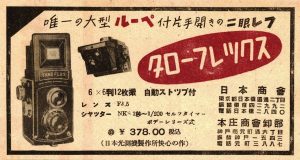
One of those companies was Taron. Taron was originally founded in Tokyo in the very late 1930s as Nippon Kōsokki Seisakusho by Yanagihara Tasaburo, making shutters for Mamiya and a variety of Japanese companies. By 1943, Nippon Kōsokki Seisakusho created it’s first camera, a clone of the German Rollei TLR called the Taroflex. At the time of it’s release, there were a huge number of Japanese companies making clones of German TLR cameras and a few Japanese language articles from after the war suggested that the Taroflex was one of the better Japanese TLRs, but it struggled to gain any significant market share and was not continued after the war.
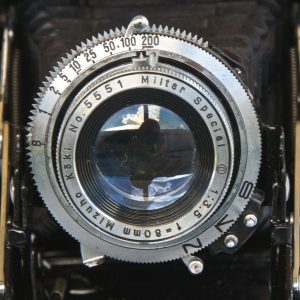
By far, Nippon Kōsokki Seisakusho’s most successful products were their NKS shutters that were copies of the German Prontor II shutter. Many Japanese medium format cameras from the 40s and 50s had NKS shutters including early Yashica TLRs. Nippon Kōsokki Seisakusho survived World War II and would continue making shutters at least through the end of the 1950s. In 1955, they would return to making cameras, with their first Taron 35mm rangefinder camera.
Nippon Kōsokki Seisakusho’s 35mm cameras were moderately successful, at least enough that in 1959, the company changed it’s name to K.K. Taron, as it was their most successful product at the time. There is very little information out there about the history of the company and what they did at this time, but it would appear that Taron had little interest in being a market leader as none of it’s cameras were revolutionary, and often shared feature sets with that of many other Japanese companies.
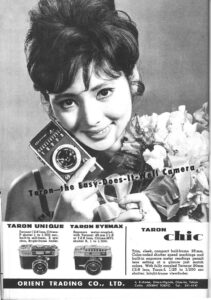
So it was probably a bit of a shock when in 1961 the company released the Taron Chic. A vertical half frame 35mm camera, the Taron Chic looked like no other camera out there…or did it?
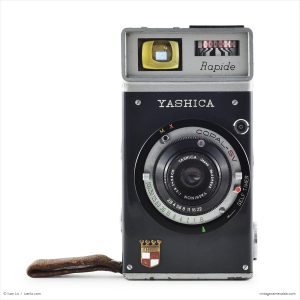
In a strange twist, another, nearly identical camera to the Chic was released by Yashica called the Rapide in 1961. Both cameras had elongated rectangular bodies that shot 18mm x 24mm half frame images on regular 35mm film, both cameras had a default landscape orientation due to the film travelling vertically, and both cameras had an uncoupled selenium exposure meter.
There were some differences as the Yashica had a slightly wider 28mm lens vs the 30mm in the Taron, and it came with a Copal leaf shutter with a selection of speeds from 1 – 500 whereas the Chic used a Seiko shutter with a smaller spread of speeds. The light meters worked differently between the two with the Chic’s facing forward and relying on a match-color system instead of LV or EV numbers, and the Yashica had a top mounted meter and gave readings using normal EV numbers.
There’s enough similarity between the two that it’s hard to believe that two such similar cameras that looked nothing like anything that came before them, would both make their debut in 1961. Did Yashica and Taron have some kind of arrangement where one company produced the main guts of the camera and the other marketed their own version for some kind of behind the scenes swap of technology, similar to how Riken (Ricoh) and ANSCO traded photocopier technology for the Anscomark M rangefinder.
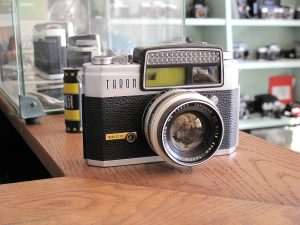
There’s very little info about these two cameras to begin with, so uncovering the arrangements of how they might have been related is something we’ll likely never know, but I have to believe there was something going on there.
Edit (10/3/2019): After posting this review, I found an article about “Sub-35mm cameras” in the August 1963 issue of Modern Photography and it mentions the Taron Chic as having a list price of $49.95. This confirms the Chic sold for less than the Yashica Rapide which was listed with a price of $60 in 1961.
Edit (12/3/2020): Recently I found a short review of the Taron Chic in the December 1985 issue of Jason Schneider’s Camera Collector column in Modern Photography. He looks back at a variety of 35mm half frame cameras, including the Chic.
Taron would go out of business by the end of the decade and the fact that very few Taron Chics show up in the used market today, suggest that very few were ever made. My best guess is that these cameras were produced probably for no longer than a year or two. Yashica didn’t produce the Rapide very long either, despite continuing to be a successful company through the 1970s, so it’s likely that the vertical half frame format just wasn’t very popular.
Today, I would be willing to bet that a large number of collectors aren’t aware that the Taron Chic ever existed. This is not only an uncommon camera to find, it’s also uncommon for anyone to talk about it. If you are interested in strange looking cameras, or have a soft spot for half-frame 35mm cameras, it’s a must have, but for everyone else…
My Thoughts
I had been on the lookout for a Yashica Rapide for quite some time, as I was interested in it’s vertical form factor and unique shape. I’ve used other vertically traveling half frame cameras before. The Agat 18K and the Yashica Samurai both orient half-frames in a landscape position, and combined with their good optics, make for a very economical camera that produces images that as long as you don’t blow them up too much, don’t look much different from a normal “full frame” 35mm camera.
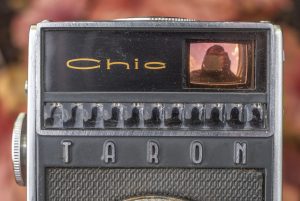
My search for the Rapide is still ongoing, but last winter, I stumbled upon this Taron Chic and thought that I might have stumbled upon a rebadge of the Yashica. Despite both being very similar in design, and both debuting in 1961, I’m still not sure that’s the case. There’s enough differences between the two that their existence could just be an incredible coincidence.
When I first handled the Chic, I was both impressed with it’s compactness and quality. The camera is small, about as wide and deep as a pack of cigarettes (if anyone remembers those) and a tad taller. Weighing 374 grams, I wouldn’t describe it as heavy, but for it’s small size, I think the best word to describe it as dense.
The camera body is all metal, and with it’s mostly sharp squared off corners, I wouldn’t want to drop this on my bare toe. The camera may have benefited a bit from having more rounded corners for ease of getting in and out of your pocket or a small purse. With a name like “Chic”, I have a feeling that women were in mind when the camera was being designed. Still, the camera has a nice appearance with a nice retro typeface for the gold silk screened “Chic” logo and engraved metal Taron name plate.
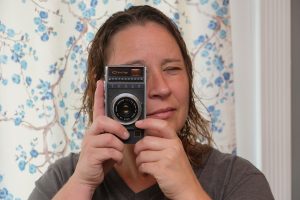
The camera is meant to be used in an upright position, with the viewfinder held to the photographer’s right eye. The shutter release is near the 5 o’clock position of the shutter, and is most comfortably accessed with the photographers left index finger. I tried holding the camera while tripping the shutter release with my right index finger, but that felt awkward to me, and I was worried that my hand could accidentally block the lens, so I shot the camera holding it like in the image to the right.
In the event you want to shoot images in portrait orientation with the camera turned to it’s side, the position of the shutter release is quite awkward. I would have preferred if it was on the side of the camera somewhere, rather than the front.

With the camera in it’s normal vertical orientation, the top plate is almost entirely dominated by the light meter which like many meters from the 1960s, uses a form of exposure values. But unlike most meters from the 1960s, rather than indicating EV numbers, the Chic uses a proprietary exposure color system with five colors from blue to red and black notches in between each color which represent normal EV numbers of 8 – 17.
The meter is uncoupled to the shutter, so how it was designed to work was with the meter set to an ASA film speed of anywhere between 10 and 800 and the camera pointed at an intended subject, the needle would point to one of the five colors which are duplicated around the outer perimeter of the shutter. An intermediate value can also be indicated by a black notch.
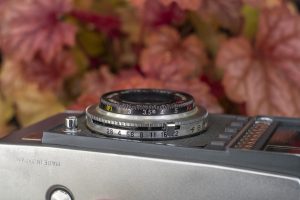
F/stops are indicated around one side of the shutter from 2.8 to 22, with a metal aperture selector that when resting in it’s normal position, slides into a notch in the shutter’s outer ring, effectively coupling the aperture selector to the shutter speed ring. Shutter speeds are not indicated anywhere on the camera, but are stated to be between 1/30 and 1/250, plus Bulb (which is indicated). Both the aperture and shutter speed selectors are infinity variable with no click stops between any setting, which makes getting an exact setting difficult to ascertain.

When the photographer is getting ready to take a photograph, he or she will look at the exposure color indicated by the meter, and turn the shutter speed ring so that it matches that color or an intermediate black notch. With the aperture selector in it’s normal position, it will move with the shutter speed, giving an appropriate shutter speed and f/stop for the lighting that the meter has detected. Since the combinations of f/stops and shutter speeds are infinitely variable, it is impossible to get an exact measurement of each. Based on my own tests (and guesses), these combinations are.

If you do not wish to use the exposure color system, or in my case, have a dead meter, you can override the coupling by pulling back on the aperture selector to pull it out of the notch on the shutter speed ring and then choose any combination of f/stops or shutter speeds you wish. The biggest issue of course, is that the shutter speeds aren’t indicated anywhere, you just have to choose based on my estimations. I found that for average outdoor light with a 100 or 200 speed film, the Green setting works well.
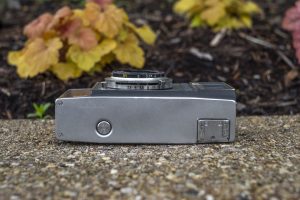
The camera’s right side is pretty barren, featuring only the rewind release button and accessory shoe which is something that I doubt would have ever been used on a camera like this. Although it does support flash sync via a PC port on the front of the camera, I just cannot picture anyone wanting such a small camera and then attaching a big honking flash to it.
Although I don’t show it, on the side of the camera opposite of the exposure meter, there is a 1/4″ threaded tripod socket for those times when you might want to take long exposures using Bulb mode. The shutter release button is threaded for a shutter release cable, which would make this possible.
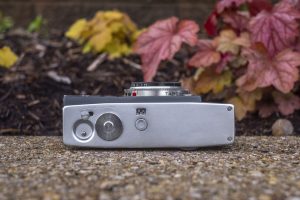
Things are slightly more interesting on the left side. There is a recessed film door release with a lock override above it. To open the film back, you must slide the lock from L to O, while simultaneously pressing the button.
Next to the door release is the rewind knob, which when in rewind mode, can be pulled out slightly to get a better grip on, and finally the manually resetting exposure counter. This being a half frame camera, the exposure counter goes up to 72 exposures, which if indicated on a single dial, would be prohibitively hard, so you’ll notice there’s two sets of exposure numbers, the first 1 through 36, and then 37 through 72. The idea is to let the exposure counter rotate twice, and you just have to keep track yourself if you are on the first or second half of the roll.
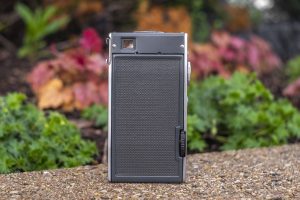
The back of the camera shows only the viewfinder and film advance wheel near the bottom right corner. With the camera held in it’s typical upright position, the film advance wheel must be rolled down to advance the film,

With the back of the camera open, film loads left to right (with the camera on it’s side) or town to bottom with it in normal orientation. It looks like pretty much every other half frame 35mm camera with a small film gate and a fixed take up spool. The shorter film gate means that less film is wasted at the beginning and end of each roll of film, so if you’re careful, you should be able to get 3 to 4 extra exposures on a single roll of film, meaning normal 24 or 36 exposure rolls of film should be good for about 52 or 76 exposures.
The viewfinder of the Chic is big enough to be usable by people with prescription glasses and in it’s horizontal orientation feels very familiar compared to other 35mm cameras. Had the camera not been such a weird shape, you could easily mistake shooting it for a “full frame” 35mm camera. There is what looked to be a projected frame line with manual parallax correction marks in mine, but it had desilvered to the point where I could only tell it was there by pulling it away from my eye.
Despite it’s non-standard shape, the Taron Chic has everything an amateur would need to make good photos. Although I appreciated the vertical nature of the camera to keep half frame images in a normally horizontal orientation, I thought the ergonomics of the camera could be better. Questionable ergonomics can be forgiven if the camera makes good images, so does it?
My Results
Not having ever shot the Chic before and also not being totally confident in how the exposure system worked on the camera, for it’s first roll, I decided to play it safe and loaded in a roll of fresh Fuji 200. I figured I would shoot it with both the shutter speed and aperture both set in the middle, hoping that I would be around 1/100 and f/11. Knowing the latitude of Fuji 200, as long as I stayed out of direct sunlight and extreme shade, I figured I would rely on the “Outdoor Eight Rule” to get me some decently exposed images.
Whether by accident or luck, after developing the film, I was rewarded with a roll of mostly well exposed and focused shots. The Chic being a scale focus camera, you have to guess the distances of your images and hope that the depth of field is wide enough to keep everything sharply in focus.
I was unable to find a user manual for this camera online, so I’ve never seen any type of official depth of field chart. I have to assume that it is similar to other half frame scale focus cameras like the Fujica Drive, in which f/11 @ 6 ft gives you a depth of field of 3.5 ft to 23 ft, and the Group setting gives 4.8 ft to Infinity.
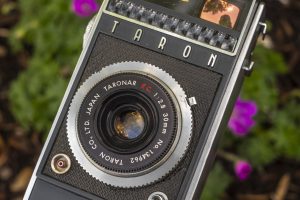
Cameras like the Taron Chic were designed to be as easy as possible, and with the colored exposure value system and a super wide depth of field, focusing aides like a rangefinder or other device aren’t all that necessary. Since the meter on this example was inoperable, and without any exact measurement of shutter speed, I was only able to guesstimate the camera’s settings, but clearly that was enough as the images in the gallery above look great.
I was never able to find any information about the make up of the 30mm Taronar lens, but based on the sharpness across the frame and little to no vignetting shown in the images, my best guess is this has to be a 4-element design. The Soviet Agat 18K half frame camera also has a 4-element lens that delivers similar results, so I concluded it was likely the same.
The Taron Chic is a neat camera that is capable of some really fantastic shots. It is clear that the mechanics of the camera were solid, but I’m still not sold on the ergonomics. Doing a quick comparison of the Yashica Rapide, that camera’s side mounted shutter release seems a bit more logical to me, and the position of the meter on the top of the camera seems like it would be more effective, but without having one to test, I can’t be sure.
This camera wasn’t produced for long, but I’m not entirely sure that has anything to do with it’s design, rather Taron going out of business a couple of years later and the disappearance of half frame cameras (in the United States) likely was a factor as well. Regardless, there aren’t many cameras like it. It’s a cool looking camera that is easy to use and makes good images, and I am happy to have it in my collection. They don’t show up for sale often, so if you’re looking to pick one up, you’ll need to be patient. Just don’t over pay for one.
Related Posts You Might Enjoy
External Links
https://vintagecameralab.com/taron-chic/
http://www.subclub.org/shop/taron.htm

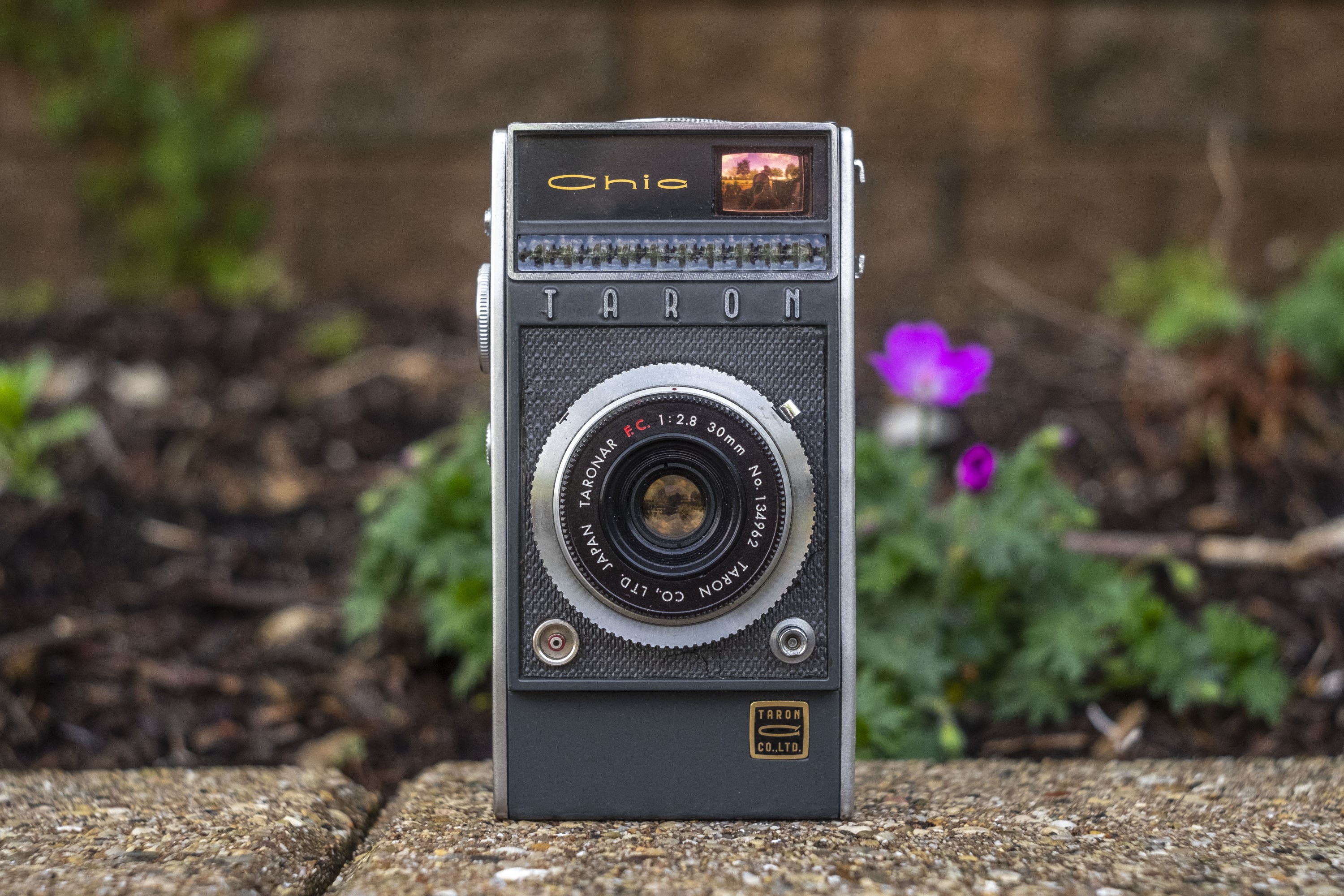
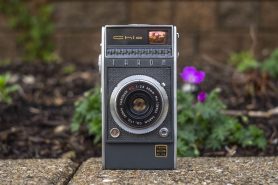
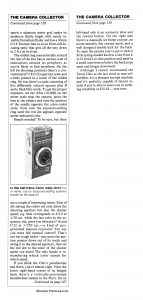
















Great review Mike, as usual. I was especially interested in this one as I have a Chic in my collection. Yours is the only other I’ve seen or even heard about, they do seem to be a bit rare. Unfortunately, I don’t think mine works. I haven’t done much with it but your article and the pictures you got from you’s have inspired me to get mine out again to determine what it needs. I also enjoyed your Taron history. I’ve a few different Taron’s but as of yet haven’t researched or shot any of them. Again, you’ve inspired me to get on it! Thanks again Mike, and keep it up. Your reviews are always enjoyed!
Thanks for the compliments Ed! Im glad that it was something that caused you to dig out your sample. The camera is pretty basic, and while I wouldn’t expect your meter to work, I feel there’s a good chance it can still make photos. I say, give it a shot!
Hmmm … Are we starting to see an “Eckman Effect” on prices over at That Famous Auction Site? A few Rapides and one Chic are available … at $200 plus!
I’ve often wondered what kind of impact my reviews can sometimes have on the prices of cameras out there (if any at all)! Based on the positive feedback from this article, I wouldn’t be surprised to think that at least a few potential buyers dug a little deeper into their wallets!
I will tell you though, I’ve been looking for a Rapide for longer than the Taron Chic, and $200 and up seems to be the going rate for all of them. They certainly don’t show up for cheap!